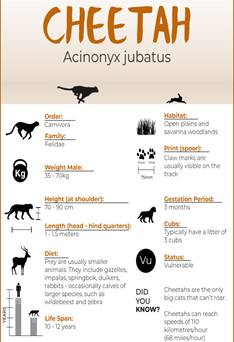

Context
African Cheetahs to be fed through traditional Boma technique in Kuno National Park
About
About Boma technique:
- The Boma capturing technique, which is popular in Africa, involves luring of animals into an enclosure by chasing them through a funnel-like fencing.
- The funnel tapers into an animal selection-cum-loading chute, supported with grass mats and green net to make it opaque for animals, which are then herded into a large vehicle for transport to another location.
- This old technique was earlier utilised to capture wild elephants for training and service.
About Cheetah:
- The cheetah, Acinonyx jubatus, is one of the oldest of the big cat species, with ancestors that can be traced back more than five million years to the Miocene era.
- The cheetah is also the world’s fastest land mammal.
- It is listed as vulnerablein IUCN red listed species.
- The country’s last spotted feline died in Chhattisgarh in 1947. Later, the cheetah — which is the fastest land animal — was declared extinct in India in 1952.
- The Asiatic cheetah is classified as a “critically endangered” species by the IUCN Red List, and is believed to survive only in Iran.
Re-introducing Cheetah in India:
- The project to translocate cheetahs from Africa to Indiais a long-term one being implemented by the environment ministry with the help of the Wildlife Institute of India.
- The Supreme Courtappointed an expert panel, which approved Kuno Palpur as the possible location for cheetah relocation.
- In the past six months, the Madhya Pradesh forest department has relocated villagers from Kuno and has prepared an enclosure with round-the-clock surveillance for reintroduction of cheetahs.
About Kuno National Park:
- Kuno National Park has spread over an area of 748.76 sq. km.
- It is located in the Sheopur district of Madhya Pradesh.
- Kuno River, one of the major tributaries of Chambal River flows through the entire length bisecting the National Park division.
- Kuno Park is known for the leopard, Jackal, Chinkara.
- Wildlife Institute of India and Wildlife Trust of India had shortlisted Palpur-Kuno Park as habitats for Cheetahs and Asiatic lions.
- Cheetah which once roamed in the northern plains of India became extinct in India in 1948.
- Plans to reintroduce Cheetah in Kuno National Park from South Africa are underway.
- The Kuno has the potential to carry populations of all four of India’s big cats the tiger, the leopard, the Asiatic lion and also cheetah, all four of which have coexisted within the same habitats historically before they were exhausted thanks to overhunting and habitat destruction.


